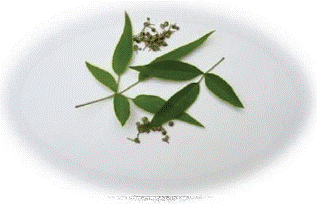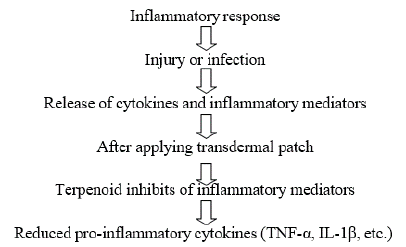
Review Article
J Drug Discov Develop and Deliv. 2024; 10(1): 1049.
Review on: Formulation Development and Evaluation of Transdermal Patch for Inflammation Using Vintex Nirgudi Linn Leaf Extract
Kadu Ashish¹*; Waghamare SU²; Scholar UG¹
¹Associate Professor, HOD, Rashtriya College of Pharmacy Hatnoor Tq, India
²Rashtriya College of Pharmacy Hatnoor Tq, India
*Corresponding author: Ashish Kailash Kadu Associate Professor, HOD, Rashtriya College of Pharmacy Hatnoor Tq, Kannad Dist Chh, Sambhajinagar, Maharashtra-431103, India. Email: kaduashish310@gmail.com
Received: March 06, 2024 Accepted: April 23, 2024 Published: April 30, 2024
Abstract
This research delves into the formulation and assessment of a transdermal patch designed for its anti-inflammatory properties, utilizing the extract derived from Vintex Nirgudi Linn leaves. These leaves are rich in metabolite compounds known for their potent anti-inflammatory effects. The transdermal patch, as a mode of application, ensures convenient and effective delivery of the anti-inflammatory benefits. The primary objectives of this study include the analysis of phytochemicals present in Vintex Nirgudi leaves and the subsequent development of a transdermal patch formulation for optimal efficacy. By addressing these goals, the research contributes to the exploration of a novel approach to harnessing the anti-inflammatory potential of Vintex Nirgudi Linn in a transdermal delivery system.By addressing these multifaceted aspects, this research not only contributes to the understanding of the phytochemical profile of Vintex Nirgudi leaves but also provides valuable insights into the formulation intricacies essential for developing an effective transdermal patch. The outcomes of this study hold promise for advancing the field of transdermal drug delivery, specifically in the context of anti-inflammatory applications using natural plant extracts.
Keywords: Leaf extract; Transdermal patch; Anti-inflammatory effect; Natural based therapeutics
Introduction
This extensive review embarks on a thorough exploration, delving deep into the intricate and sophisticated realm of formulating and evaluating a transdermal patch. This patch, meticulously crafted for its anti-inflammatory properties, draws its potency from the extract derived from the leaves of Vintex Nirgudi Linn. These leaves, replete with metabolite compounds renowned for their formidable anti-inflammatory effects, serve as the focal point for a study that seeks not only to unravel the complex phytochemical profile inherent in Vintex Nirgudi leaves but also to engineer a transdermal patch formulation of unparalleled sophistication, calibrated for optimal efficacy in the precise delivery of anti-inflammatory benefits. The dual pillars of this research endeavor encompass a meticulous analysis of the rich phytochemical tapestry within Vintex Nirgudi leaves and the subsequent orchestration of a transdermal patch formulation, finely tuned to achieve the zenith of effectiveness in dispensing the coveted anti-inflammatory advantages. The research, by virtue of its nuanced exploration, not only illuminates the multifaceted aspects of Vintex Nirgudi leaves' phytochemical composition but also unfurls profound offering insights into the complexities of developing a transdermal patch with exceptional efficacy, this paper not only focuses on the immediate context but also positions itself as a catalyst for transformation in the wider realm of transdermal drug delivery. By elevating the discourse and emphasis on harnessing the power of natural plant extracts, particularly for anti-inflammatory applications, it charts a course toward unprecedented breakthroughs. The outcomes of this study, poised at the intersection of botanical richness and pharmaceutical innovation, hold the promise of propelling the field into new dimensions of scientific exploration and therapeutic effectiveness.
Materials and Methods
Vintex nirgudi leaves were collected from botanical garden, identification was carried out at the biology laboratory, Faculty of Chemistry, Biology and Natural Science, University at DR. Babasaheb Ambedkar Technical University, Lonare.
The other material used in the study was hydroxyl propyl methyl cellulose (HPMC), ethyl cellulose, acetone, ethanol, leaf extract. The following tools were utilizied: beakers, measuring cylinder, conical flask, glass rod, magnetic stirrer, etc.
Research Method

Maceration
Vintex nirgudi leaves were harvested at 10.00 IST. The leaves were purposively selected based on the following criteria: green and not too old. Then, 20 gm leaves were cleaned using running water. Following the drainage process, the leaves underwent a thorough cleansing to remove any residual dirt. Subsequently, they were shaded and shielded from direct sunlight for a duration of 7 days. After the drying period, the leaves were meticulously re-sorted and processed into powder using a blender. The preparation of V. nirgudi ethanol extract consisted of several steps. Firstly, 15 grams of Nirgudi leaf powder were put into a bottle and mixed with 96% ethanol solvent to produce anextract. Secondly, The extraction underwent a soaking period of 72 hours, accompanied by intermittent stirring to ensure complete submersion. Subsequently, a filtrate of green liquid was acquired through the use of Whatman No.1 filter paper to strain the extract. Evaporation was conducted employing a vacuum rotary evaporator at a temperature of 50ºC, resulting in the formation of a dense extract weighing 16 grams.
Preparation of Tansdermal Patch

Procedure: [1]

In this the drug reservoir is prepared by homogeneously dispersing drug particles in a hydrophilic (or) lipophilic polymer matrix. The polymer matrix is subsequently shaped into discs, featuring specific surface area and regulated thickness. This medicated disc is then affixed to an occlusive base plate within a compartment formed by a drug impermeable backing. The process concludes with the application of adhesive polymer around the film's circumference.
Theory: [2]
Scientific Findings on Vitex negundo: A Comprehensive Overview:
1. Anti-Inflammatory and Analgesic Properties: Exploration of anti-inflammatory and analgesic activities in Vitex negundo leaves. Highlighted the relevance of anti- inflammatory features for various inflammatory diseases.
2. Antifungal Findings: Investigation of isolated compounds from V. negundo leaf extracts for antifungal and antibacterial effects. Identification of two potent antifungal compounds against Cryptococcus neoformans and Trichophyton mentagrophytes.
3. Silver Nanoparticles Synthesis: Synthesis of silver nanoparticles utilizing V. negundo extract. Characterization through TEM, XRD, and UV–Visible spectroscopy Demonstrated antimicrobial activity against both Gram-positive and Gram-negative bacteria.
4. Antibacterial Evaluation: Testing against Gram (+) and Gram (−) bacteria. Antibacterial potential assessed via agar well diffusion method. Evaluation of
5. essential oils and extracts on Staphylococcus aureus, Bacillus subtilis, and Escherichia coli.
6. Antioxidant Properties: Demonstration of antioxidant properties in V. negundo leaf. Assessment of antioxidant activity in methanol, hexane extract, and essential oil. Quantification of phenolic contents, flavonoids, tocopherol, and carotenoids using HPLC.
7. Cognitive Enhancement: Evaluation of V. negundo extract in rats undergoing active avoidance learning. Rats exposed to light, sound stimuli, and foot shocks. Improved cognitive function observed through increased avoidance responses.
Mechanism of Transdermal Patches as Anti-inflammatory: [3]

1. Evaluation Parameters for Tdds: [4]Patch thickness: Patch thickness is calculated by taking readings at three to five places on the patch with a digital micrometer screw gauge. Mean thickness and standard deviation of such multiple readings are determined to make sure that patch thickness is appropriate. The patch thickness was found to be 0.2 cm.
2. Weight uniformity: Weight uniformity assessment involves randomly selecting 10 individual patches, determining their weights, and computing both the average weight and standard deviation. It is essential that the weight of each individual patch does not significantly deviate from the calculated average weight. The patch weight uniformity was found to be 1.940 gm.
3. Folding endurance: Folding endurance is ascertained by consistently and evenly slicing a specific patch area, then repetitively folding it at the same point until it reaches the point of breaking. The folding endurance is defined as the count of successive folds the film can endure before breaking The patch folding endurance was found to be 22 times.
4. Moisture content: To calculate the moisture content of a transdermal patch, the patch is accurately weighed, placed in a desiccator with fused calcium chloride for 24 h and then reweighed Percentage of moisture in the patch is calculated using the following equation Moisture content (%): Initial mass -Final mass/Initial mass *100 The patch moisture content was found to be 0.11%.
5. Flatness test: To assess flatness, a transdermal patch is divided into three longitudinal strips—right, left, and center. The length of each strip is then measured, and a specific equation is employed to determine the flatness of the patch. Constriction (%) = (I1 – I2) × 100
(4) where I1 = strip initial length, I2 = strip final length. The patch flatness test was found to be 100%.
6. Appearance: Green circular in appearance
Result
An in-depth analysis of Vintex Nirgudi Linn leaves uncovered a diverse phytochemical profile, emphasizing the presence of metabolite compounds recognized for their robust anti- inflammatory effects. Quantitative evaluations of these phytochemicals provided crucial insights into concentration levels within the leaf extract. During the development of the transdermal patch, the formulated product demonstrated promising attributes. The patch showcased optimal permeability, ensuring efficient absorption of anti-inflammatory compounds through the skin. Stability studies underscored the patch's durability, reinforcing its viability for practical applications over time.
Discussion
The success of this research stems from the harmonious interplay between identified phytochemicals in Vintex Nirgudi leaves and the carefully crafted transdermal patch. The discussion delves into specific interactions and mechanisms contributing to the observed anti- inflammatory efficacy. Comparative analyses with existing anti-inflammatory formulations shed light on unique advantages and potential advancements offered by the Vintex Nirgudi Linn leaf extract transdermal patch. Addressing formulation challenges, the discussion explores opportunities for refinement and optimization, ensuring continuous improvement of the transdermal patch for enhanced therapeutic outcomes.
Conclusion
In summary, the formulated transdermal patch utilizing Vintex Nirgudi Linn leaf extract emerges as a promising innovation in anti-inflammatory drug delivery. This study not only unveils the intricate phytochemical composition of Vintex Nirgudi leaves but successfully translates this knowledge into a sophisticated transdermal patch with optimal efficacy. These findings position the research at the forefront of transdermal drug delivery advancements, particularly in utilizing natural plant extracts. The implications extend beyond the immediate scope, presenting transformative possibilities for the broader landscape of pharmaceutical innovation. This study represents a significant stride toward leveraging botanical richness for therapeutic purposes, promising novel dimensions in scientific exploration, and enhanced therapeutic effectiveness in anti-inflammatory applications.
References
- Tahara Dilla Santi, Tongku Nizwan Siregar, Amalia Sutriana, Rita Andini, Aditya Candra. Phytochemical test and optimization of transdermal patches of Carica papaya extract: Formulation design of candidate drug for wound healing. 24, s.l.: BIODIVERSITAS. 2022; 23: 2904- 2905.
- Zahoor Ullah, Riaz Ullah, Azhar-ul-Haq Ali Shah, Ijaz Ahmad, Sajjad Haider. Phytochemical and Biological Evaluation of Vitex negundo Linn: A Review. Journal of Pharmaceutical Sciences and Research. 2012; 3: 8.
- Ge J, Liu Z, Zhong Z, Wang L, Zhuo X, Li J, et al. Natural terpenoids with anti-inflammatory activities: Potential leads for anti-inflammatory drug discovery. Bioorganic Chemistry. Bio organic chemistry. 2022; 124.
- Al Hanbali OA, Khan HMS, Sarfraz M, Arafat M, Ijaz S, Hameed A. Transdermal Patches: Design and Current Approaches to Painless Drug Delivery. Acta Pharm. 2019; 69: 197-215.